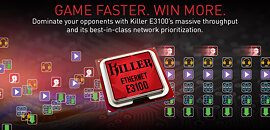- Joined
- Oct 9, 2007
- Messages
- 47,675 (7.43/day)
- Location
- Dublin, Ireland
| System Name | RBMK-1000 |
|---|---|
| Processor | AMD Ryzen 7 5700G |
| Motherboard | Gigabyte B550 AORUS Elite V2 |
| Cooling | DeepCool Gammax L240 V2 |
| Memory | 2x 16GB DDR4-3200 |
| Video Card(s) | Galax RTX 4070 Ti EX |
| Storage | Samsung 990 1TB |
| Display(s) | BenQ 1440p 60 Hz 27-inch |
| Case | Corsair Carbide 100R |
| Audio Device(s) | ASUS SupremeFX S1220A |
| Power Supply | Cooler Master MWE Gold 650W |
| Mouse | ASUS ROG Strix Impact |
| Keyboard | Gamdias Hermes E2 |
| Software | Windows 11 Pro |
Rivet Networks today formally launched its 2.5 Gbps Killer Ethernet E3100-series NICs targeted at gaming notebooks and motherboards. These 2.5 GbE solutions are based on Intel's i225-series "Foxville" PHY chips. The new E3100G is based on the i225-V, and is targeted at platforms that have chipset-integrated MAC (most Intel chipsets). The E3100X is based on the i225-LM, and has an integrated MAC, making it better suited for gaming notebooks with Ryzen 4000H-series processors. The software side of things is where Rivet's innovations are.
The Killer Prioritization Engine detects network traffic from games and prioritizes it. This should improve latencies when competitive gamers are also streaming on the side. Under extreme network stress (think gaming+streaming+downloads), Rivet claims the tech can improve gaming latencies by up to 3 times. Next up is GameFast tech, an optimized HSP component of the driver that reduces CPU utilization by up to 10% and the network stack's memory footprint by 20%, compared to other 2.5 GbE solutions. Lastly, there's support for DoubleShot Pro, Killer's network teaming tech that lets you combine bandwidth of your wired and wireless network interface for up to 4.9 Gbps bandwidth. The Killer Control Center 2.0 app gives you control over this and the other features.

View at TechPowerUp Main Site
The Killer Prioritization Engine detects network traffic from games and prioritizes it. This should improve latencies when competitive gamers are also streaming on the side. Under extreme network stress (think gaming+streaming+downloads), Rivet claims the tech can improve gaming latencies by up to 3 times. Next up is GameFast tech, an optimized HSP component of the driver that reduces CPU utilization by up to 10% and the network stack's memory footprint by 20%, compared to other 2.5 GbE solutions. Lastly, there's support for DoubleShot Pro, Killer's network teaming tech that lets you combine bandwidth of your wired and wireless network interface for up to 4.9 Gbps bandwidth. The Killer Control Center 2.0 app gives you control over this and the other features.

View at TechPowerUp Main Site





